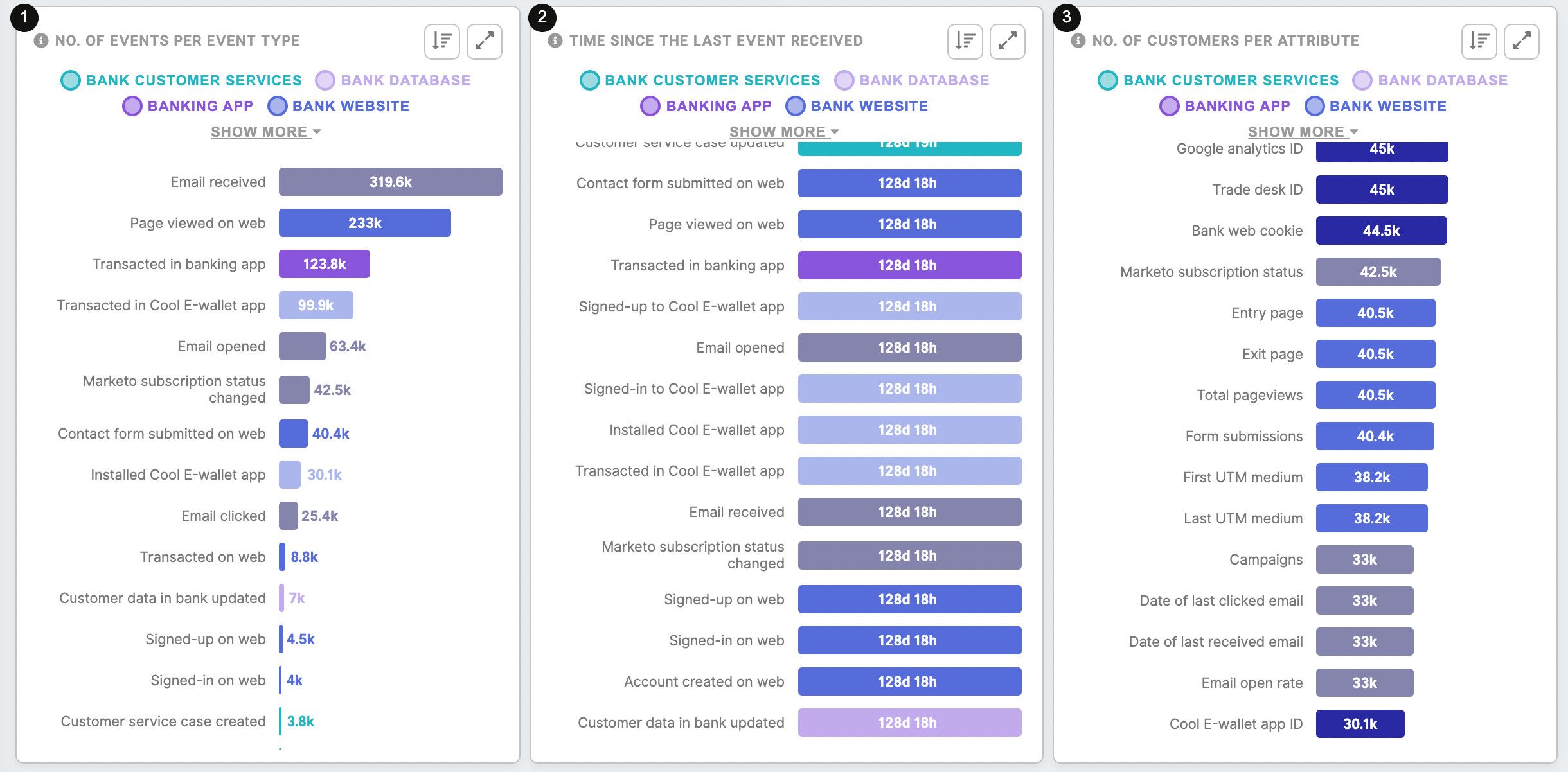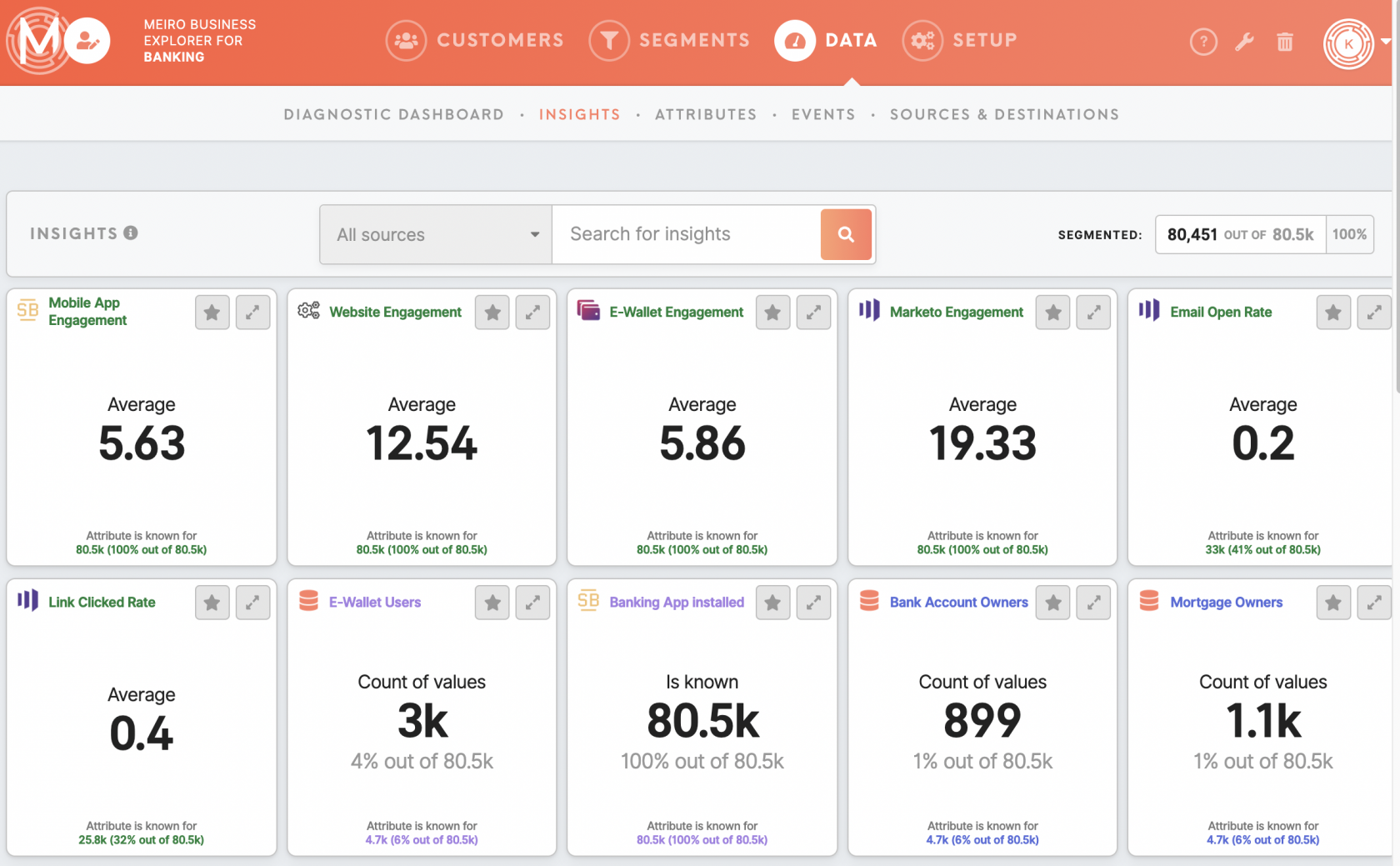Understand the bigger picture of your data
|
Learn from this article about: |
Diagnostic Dashboard
It is easy to get lost in the sea of data. The Data tab will help you to understand the bigger picture of your available data.data: Diagnostic Dashboard, attributes, events, sources, destinations, as well as insights.
Diagnostic Dashboard
Find in Diagnostic Dashboard information about your customer's data: when it was updated, total number of customers, events, attributes and more.
LookCheck atout:
- number of connected sources,
- customer attributes,
- customer attributes values,
- total events,
- identified customers,
- the average number of events per
customercustomer.
The example above shows: 4 available data sources that have collected data for 76,300 customers profiles, 375,400 events, 86 attributes, in total giving 1.4 million attribute values. This gives an average of 5 events per customer.
Check These In the case above we can also see that the number of identified customers overtime is increasing, as well as the number of events is Shows the number of customers that are identified on 1 through x sources. The higher the number of identified customers in the higher cross-data sources, the better the performance of the customer profiling process, and the better the quality of the customer profile output. The chart above shows that the highest number of customers (44.3 k) is identified only in 1 source, while 31.2k customers across 2 sources., 1.4k (3 sources), 2.5k (4 sources), 236 (5 sources), 796 (6 sources), 42 (7 sources). Shows the data sources that hold the highest/lowest amount of customers. This can help to see which data sources are the most helpful for collecting the data about customers. The chart above websites and Marketo collect the highest amount of customers data, while Net promotes score the lowest. In the example above we can see that the most popular is “Email received". The example above shows that the oldest event is "Contact form submitted on the web", 128 days, 18 hours. This time is extremely long, requires investigation. In the example above, we can see that, for example, Google Analytics ID, Trade Desk ID are the most populated for the customers (45 000) Check out in other tabs what attributes, events, sources and destinations are available. Attributes: based on attributes and its values you can segment audiences. Events: are used in each customer profiles to describe customer activity (events). Sources: from where customer data is coming from. Destinations: where segmented data can be loaded to activate it futher. Learn more: about
The New Events Over Time(1) and the Number of Identified Customers Over Time (2)
charts
helpsto highlightfor any dips and spikes in the number of customer events and identified customers. numbernumbers should broadly align with your customer engagement and acquisition strategy,strategy. we canE.g. expect a hike in numbernumbers following a planned campaign.increasing.increasing.
Customers updated in the last 7 days (3)
summarizesSummarizes updateupdates for customer entities for the last 7 days. Immediate updates happen each time when a new event arrives. Also when a customer entity merges with other customer entity. Update for all customer entities happens from 1 to 7 days (depending on the use case). The most amountmost of customers should be within the first bars, it is warning if most of the customers are at the end of the chart (>96h). In the case above customer data was not updated for a longer period of time, it is also suspicious that all results are 0, while at least one column should be filled, therefore it requires investigation.
The number of unique customers identified across x sources(1)
The number of customers identified per source(2)
The number of events per event type(1)
:
demonstratesShows how many actions customers performed, type of actions performed and on which platforms your customer is engaging the most with your brand.
The time since the last event received(2)
:
showsShows how up to date events are.
The number of customers per attribute(3)
:
helpsHelps to evaluate the scale of the information about your customers across the data sources. In this way, you can evaluate what kind of data you can use to analyse, and determine which data source holds the highest amount of the information. You can evaluate the scale of the information about your customers across the data sources.
Attributes, events, sources & destinations
Insights tab
Insights are a set of tiles that summarize the data that matter to you. Insights tab placed in the Data tab displays insight values for your whole customers' database.
highly customizablecustomized for each client, therefore to get the most out of your data, please contact Meiro team.client.
Toinsight learn what is possible with insight, please go tofrom this article.





